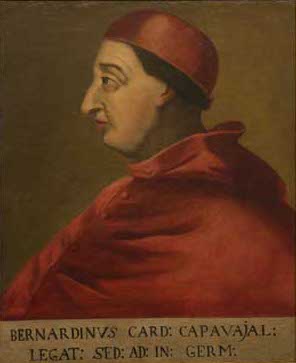Bernardino López de Carvajal facts for kids
Quick facts for kids His Eminence Bernardino López de Carvajal |
|
|---|---|
| Bishop of Plasencia | |
 |
|
| Diocese | Plasencia |
| See | Plasencia |
| Appointed | 14 January 1521 |
| Reign ended | 16 December 1523 |
| Predecessor | Gómez de Toledo Solís |
| Successor | Gutierre de Vargas Carvajal |
| Other posts | Cardinal-Bishop of Ostia e Velletri |
| Orders | |
| Consecration | 21 December 1488 by Jean Balue |
| Created Cardinal | 20 September 1493 |
| Rank | Cardinal-Bishop |
| Personal details | |
| Born | 8 September 1456 Plasencia, Extremadura, Castille |
| Died | 16 December 1523 (aged 67) Rome, Papal States |
| Denomination | Roman Catholic |
| Previous post |
|
Bernardino López de Carvajal was an important Spanish Cardinal. He was born on September 8, 1456, in Plasencia, Extremadura, Spain. He passed away on December 16, 1523, in Rome, Italy.
Contents
Early Life and Career
Bernardino was the nephew of another famous church leader, Cardinal Juan Carvajal. He quickly rose through the ranks in the church in Rome. He arrived there during the time of Pope Sixtus IV, who was Pope from 1471 to 1484.
Becoming a Bishop
Under Pope Innocent VIII, Bernardino became a bishop in several Spanish cities. He was the Bishop of Astorga in 1488. Then, he became Bishop of Badajoz in 1489. After that, he was made Bishop of Cartagena.
Diplomatic Missions
As Bishop of Cartagena, he was sent as a special representative, called a nuncio, to Spain. The Spanish monarchs, known as their Catholic Majesties, then sent him back to Rome. He served as their ambassador to Pope Alexander VI.
Becoming a Cardinal
In 1493, Pope Alexander VI made Bernardino a Cardinal. He was given the title of Cardinal of Sts. Peter and Marcellinus. Later, in 1495, he changed this title to Cardinal of Santa Croce in Gerusalemme.
Important Roles and Disagreements
In the years that followed, Bernardino was sent on important missions. He traveled twice as a special representative, called a legate, to the German imperial court. He also went to Naples and served as the Governor of Campania.
More Bishop Roles
In 1503, he became the Bishop of Siguenza in Spain. He also managed the diocese of Avellino. From 1507 to 1509, he held several high positions. He was a Cardinal-Bishop in different areas like Albano, Frascati, Palestrina, and Sabina.
The Council of Pisa
Despite his many important roles, Bernardino is best known for his part in a major disagreement within the church. He was a main leader of a group that started a separate church meeting called the Council of Pisa (1511). He organized this meeting with four other cardinals.
This happened because Bernardino was unhappy with how Pope Julius II treated him. He also sided with Louis XII of France, who had been removed from the church. This led Bernardino to take a rebellious stand.
Some people even said he tried to become a rival Pope, called an Antipope Martin VI, in Milan. People in Pisa even called him "Papa Bernardino" as a nickname.
Reconciliation and Later Life
Bernardino was known as a good thinker about religious topics. He also supported art and learning. He was seen as a virtuous person, a good speaker, and skilled in church matters.
Excommunication and Forgiveness
Because of their actions, Pope Julius II removed Bernardino and his fellow cardinals from their church positions. This decision was confirmed by another important church meeting, the Fifth Lateran Council, in 1512.
However, at a later meeting of this council in 1513, Bernardino and another cardinal formally apologized. They said they were sorry for their part in the disagreement. Pope Leo X then allowed them to return to their church offices.
Final Years and Legacy
After this, Bernardino was made Cardinal-Bishop of Ostia. He also became the Dean of the Sacred College, which is a very high position among cardinals. He welcomed two Popes to Rome: Pope Adrian VI and Pope Clement VII.
Bernardino lived in Rome under eight different Popes. He was buried in his church, Santa Croce, where a beautiful monument remembers him. He also paid for the lovely frescoes (wall paintings) in the church's apse. These paintings show the Discovery of the Holy Cross.
See also
 In Spanish: Bernardino López de Carvajal y Sande para niños
In Spanish: Bernardino López de Carvajal y Sande para niños

